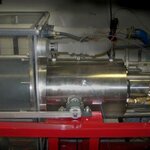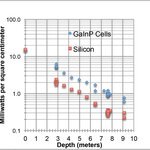Energy

A new toilet system can turn human waste into electricity and fertilizers and even reduce the amount of water needed for flushing by up to 90 percent The inventors in Singapore call it the No-Mix Vacuum Toilet and it has two chambers that separate the liquid and solid wastes. Using vacuum suction technology, like you find in airplane lavatories, flushing liquids requires only 0.2 liters of water while flushing solids require just one liter. The existing conventional commonly used in Singapore need 4 to 6 liters of water per flush so a single public toilet, that may be flushed 100 times a day…

Tapping ocean energy sources like tides and offshore wind sound fine to people who understand nothing about science (the Anything But Oil contingent) but in reality it requires pile driving, the practice of pounding long, hollow steel pipes called piles into the ocean floor to support energy turbines and other structures.
Pile driving creates loud, underwater booms that can harm fish and other marine animals so if you're thinking CO2 is better for the world, you are right.
But there may be at least one consideration that might make it more feasible. Scientists have devised the…

Scientists at Brookhaven National Laboratory have shown that ramping up the overall metabolism of algae by feeding in more carbon increases oil production as the organisms continue to grow - and that may point to new ways to turn photosynthetic green algae into tiny "green factories" for producing raw materials for alternative fuels.
But there are still obstacles that keep microscopic algae from turning into these oil producing factories. When the tiny microbes take in carbon dioxide for photosynthesis, they preferentially convert the carbon into starch rather than oils. algae produce…

Soitec, part of Euronext Paris, has announced that the U.S. Department of Energy (DOE) is giving them a SUNPATH award in the amount of $25 million to support its new North American solar manufacturing facility in San Diego, California.
SUNPATH, which stands for Scaling Up Nascent PV At Home, is part of the U.S. governments controversial efforts to increase America's manufacturing competitiveness in the solar market.
Last December, Soitec acquired a 176,000-square-foot manufacturing center on 14.8 acres of land located in San Diego to support over 300 megawatts (MW) of projects throughout San…

Heliatek GmbH, a technology company in the field of organic photovoltaics, has announced that its transparent solar films could be used to be integrated between the glass sheets of double glazed windows. These windows would look like tinted glass as the unique vapor deposition technology for the solar films allows for a homogeneous coating of the solar layer without any distracting patterns or irregularities.
The ultra-thin solar films by Heliatek lend themselves to integration between glass. The transparency level as well as the color can be tuned to suit the customers'…

New York Governor Andrew Cuomo’s rumored retreat on fracking shows just how powerful an anti-science, fear-based campaign can be. If reports are correct, Cuomo will restrict fracking to a few counties in which gas shale is far below the water table, and allow a veto to localities that are dominated by anti-fracking radicals. It's all in the name of ensuring the safety of drinking water, he purportedly believes--or protecting his political base.
Cuomo's decision validates the anti-frackers’ “study it to death” strategy. Their goal is to create the illusion that horizontal fracturing pollutes…

It sounds like a child’s question: can you generate solar power underwater? The answer, according to Phillip Jenkins and his team at the US Naval Research Laboratory, is yes. The researchers recently demonstrated a method for harvesting solar power underwater at depths of 30 feet.
Currently, the only option for underwater energy is batteries, which shortens the amount of time an underwater system can be powered. Having a source of renewable energy underwater opens up the possibility for long-term installations of autonomous systems, including systems for communication, environmental…

A new durable, environmentally-benign (we all hope) blue pigment has also been found to have unusual characteristics in reflecting heat - it's much better at it than most blue pigments in use. The compound just received patent approval and was discovered by Oregon State University scientists who were instead studying some materials for their electrical properties.
Some manganese compounds came out of a 2,000 degree Fahrenheit oven transformed into a blue color, which researchers later determined was due to an unusual "trigonal bipyramidal coordination" of their molecules that changed…

When I was small, the word “desert” conjured images of towering Saharan dunes: windswept sand punctuated by rare oases, the only sign of life an occasional animal track quickly buried by the next sandstorm. Then, when I was 13, my parents took me to the Southwest. We visited Saguaro, Joshua Tree, and other parts of the Mojave Desert, chased tarantulas, and watched cactus wrens build nests.
Since then, I’ve been hooked on the desert and the quirky plants and animals adapted to its harsh conditions. I’ve returned often: to glimpse the winter rains, stand at the lowest point on the…

When forests are logged, managed or selectively trimmed so they’ll be less susceptible to raging fires, there are usually huge piles of stumps, branches and other wood debris left laying on the ground. Now a group of researchers at the University of Washington in Seattle is developing a portable technology to turn these waste piles into treasure troves by converting them into biochar; charcoal made from plant material that can be burned for energy or applied to soils, where it helps plants grow.
“This is a way to take a lot of carbonaceous waste and convert it into a [valuable] product,” says…